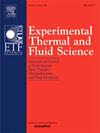Transient freezing of water in a square channel: An experimental investigation
IF 2.8
2区 工程技术
Q2 ENGINEERING, MECHANICAL
Experimental Thermal and Fluid Science
Pub Date : 2025-01-28
DOI:10.1016/j.expthermflusci.2025.111417
引用次数: 0
Abstract
This paper presents an experimental study for the transient growth of an ice layer in a square channel under laminar flow conditions and a mixed convection heat transfer regime. The ice layer was grown from a cold plate located at the bottom of the channel, capable of reaching temperatures between 0 and −20 °C. The onset of ice formation was marked by a sudden sharp increase of the cold plate temperature followed by a rapid spreading of the ice over the cold plate surface. This was attributed to subcooling effects within the thermal boundary layer of the flow. The flow field was measured using particle image velocimetry (PIV) and the ice profiles were measured at several instances of time after the onset of freezing by a visual tracing of the solid–liquid interface. In addition, a parametric study was performed regarding the effect of the cold plate temperature and the flow rate on the ice growth rate. Suitable approximations to the experimental boundary conditions were found after a detailed analysis of the cold plate’s transient temperature response, which could be readily implemented in numerical software. An important novelty of the present work is the measurement of the transient ice development of the ice-layer near the inlet of the channel, in addition to the centre of the channel where the flow is more developed. As such, a comprehensive and well-described experimental data set was generated for transient freezing in laminar internal flow. With this approach, a very good agreement was obtained between the experimental results and numerical simulations which were included to indicate the suitability of the current experimental campaign for numerical benchmarking purposes.
方形沟渠中水的瞬时冻结:实验研究
本文对层流条件和混合对流换热条件下方形通道中冰的瞬态生长进行了实验研究。冰层是从位于通道底部的冷板上生长出来的,能够达到0到- 20°C之间的温度。冰形成的开始标志是冷板温度的突然急剧上升,随后冰在冷板表面迅速蔓延。这归因于流动热边界层内的过冷效应。流场测量采用粒子图像测速仪(PIV),冰剖面测量在几个实例的冻结开始后,通过固液界面的视觉跟踪。此外,还对冷板温度和流速对冰生长速率的影响进行了参数化研究。通过对冷板瞬态温度响应的详细分析,找到了适合于实验边界条件的近似表达式,可以很容易地在数值软件中实现。本工作的一个重要新颖之处在于,除了在水流较发达的河道中心测量外,还测量了河道入口附近冰层的瞬态冰发育。因此,生成了一套全面且描述良好的层流内流瞬态冻结实验数据集。通过这种方法,在实验结果和数值模拟之间获得了非常好的一致性,其中包括表明当前实验活动对数值基准测试目的的适用性。
本文章由计算机程序翻译,如有差异,请以英文原文为准。
求助全文
约1分钟内获得全文
求助全文
来源期刊

Experimental Thermal and Fluid Science
工程技术-工程:机械
CiteScore
6.70
自引率
3.10%
发文量
159
审稿时长
34 days
期刊介绍:
Experimental Thermal and Fluid Science provides a forum for research emphasizing experimental work that enhances fundamental understanding of heat transfer, thermodynamics, and fluid mechanics. In addition to the principal areas of research, the journal covers research results in related fields, including combined heat and mass transfer, flows with phase transition, micro- and nano-scale systems, multiphase flow, combustion, radiative transfer, porous media, cryogenics, turbulence, and novel experimental techniques.
 求助内容:
求助内容: 应助结果提醒方式:
应助结果提醒方式:


